Back in Melbourne we were organising and enquiring about equipment and housing. We had bought a chain saw and small generator and were looking at tractors. Our first choice was the Bohlens HT20, but we decided that this type of tractor would not have enough power for us. After looking at several 20-25 horsepower tractors, both diesel and petrol, we decided on and bought (for delivery in June) a Satoh, later called Sally. Before the final delivery we also had a 10′ x 6′ [3m x 2 m ish]trailer and were looking for a chain and dogs. Other enquiries were made to seed farms and tree nurseries. We made a list of trees and shrubs and at that stage considered putting in an order for delivery in time for spring planting. Later, we found that we would not have time to prepare the ground this year. The decision to buy a small version of the Bush Haven Log Cabin was taken, and a deposit paid before the end of the financial year. Delivery was to be by October 24th.

The next trip to Malemijo was made on Queen’s Birthday weekend, June 14th, with the intention of rebuilding the ‘hut’ we had found – in order to have somewhere to leave tools and equipment and to live comfortably while building the house. Weather was cold at nights, and warm during the day. We went to bed early for warmth, and used the radiator. Camp was set up near the posts for the hut.
The existing posts (except two) were removed with the aid of the Jackall jack, and new post holes were dug (or the old ones expanded) using the new post-hole auger, a crow bar and post hole shovel. Small stringy-barks around the hut site were cleared. New corner posts and uprights were selected from standing live grey boxes, which were cut to length, and scarfed to take stringy-bark logs. After spending half a day scarfing one corner post with adze and chisel, we began to use chainsaw only for scarfing. With two posts in position, the first string-bark fillers were cut and put in position. for the V notch scarfings, some axe trimming of the string bark logs was necessary.
[Miriam’s note: if you look at Wikipedia, it talks about scarf joints which are a way to join two pieces of wood together end to end. In this context, though, it means creating the groove down the length of a post that notched logs will then slot into. You’ll sometimes find the word used this way in tongue and groove joints, which kind of matches the concept]
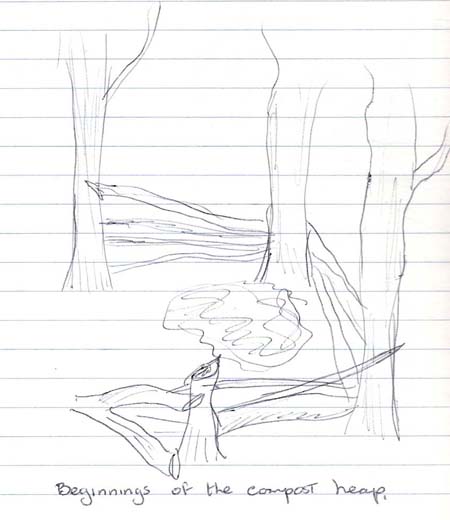
After a solid day of using the chainsaw for clearing and trimming, Mario had developed a migraine on Sunday. We decided to buy ear-muffs for the next trip. Sunday was a light work day because of the headache. One post hole had proved hard to dig , so a bucket of water was put in it overnight. By next morning the ground had softened to good clay. We began to use this for chinking the cracks in the stringybark filled-in walls. Chinking became Miriam and Joseph’s job. More post holes were dug and dead wood around the area was cleared and stacked around three box trees to become the ‘fence’ around our compost heap. The compost pile was begun with some soil and humus, our tea bags and vegetable scraps. We decided to add to its nitrogen content by making it the common urine depository. All faeces at this stage were deposited in holes dug on the eastward slope of the ridge (drainage away from the dry wash and and the main stream of Sheepstation Creek).
By time of leaving, we had two wall sections half-erected, and four posts in position, with three extra post holes dug, and covered with logs or shale. Our trailer camp-site and fireplace area was cleared and ready for quick access on the next trip.
Access was still via L-s locked gate, which had been left unlocked to enable our neighbours to get in and out.
For the first time, we left some equipment behind the black jerry-can and the small crow bar. At P- L-‘s request, we met J- C-, walked over the Council Easement and asked him to quote on clearing a track along the easement.
Hut sketch details
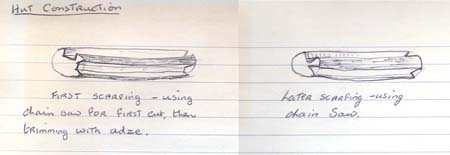
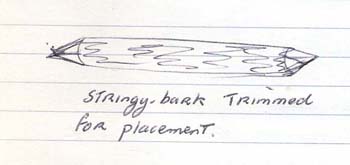
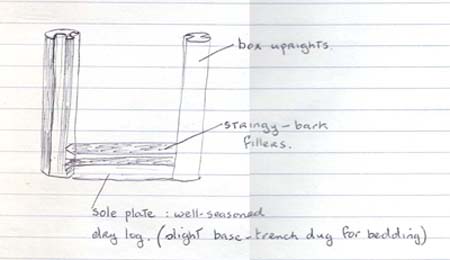
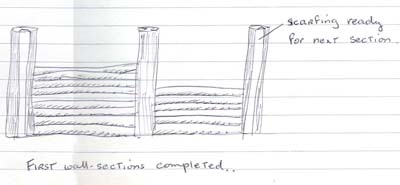


5 Responses to June – July 1976